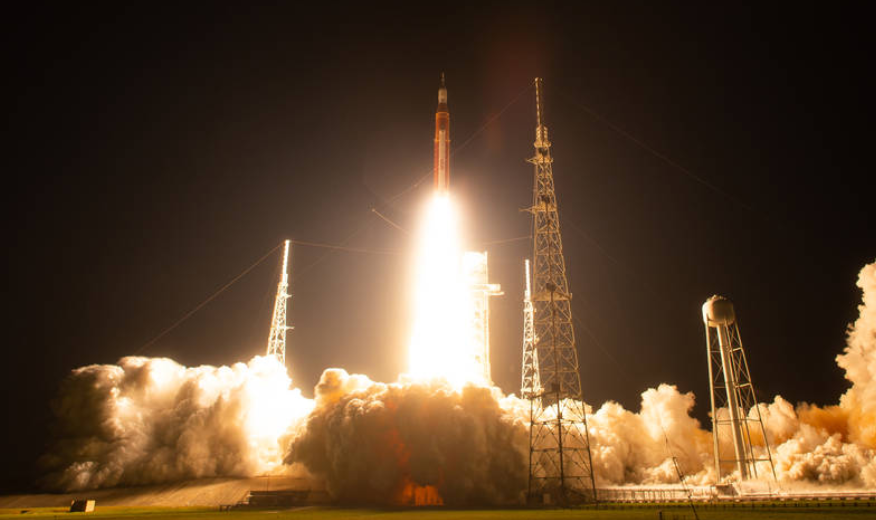
An SLS and Orion lift off on Nov. 16.
HOUSTON—With NASA’s Artemis program to extend human exploration into deep space beginning to unfold, the agency and its supporters have launched an unprecedented focus on sustainability.
They are striving to prevent the sudden cancellations witnessed in Apollo and the human lunar exploration initiatives proposed by former Presidents George H.W. Bush and George W. Bush.
Space Policy Directive 1, signed into law by former President Donald Trump in December 2017, has continued to advance with a change in administrations, as evidenced by the success of last year’s uncrewed Artemis I test flight. The directive calls for a U.S.-led return to the Moon with international and commercial partners, followed by missions to Mars.
Preserving the momentum was a theme of a two-day Lunar Surface Innovation Consortium session hosted by the Johns Hopkins University Applied Physics Laboratory. It concluded April 25 with a panel discussion entitled, “Government Collaboration to Meet Long-term Goals for a Lunar Ecosystem.” There were participants from NASA, DARPA and the White House Office of Science and Technology Policy (OSTP).
Technical and political resilience go hand in hand, stressed Pam Melroy, NASA’s deputy administrator. Melroy is also a former space shuttle commander and U.S. Air Force test and combat pilot educated in planetary and Earth sciences.
“A critical part of this is actually having a strategy that everyone has the opportunity to weigh in on and feel bought into. Importantly for all of your research partners, in particular, you have to see a clear path ahead, and that is something we are trying to do is create something that stretches out a couple of decades,” Melroy said. Last week, Melroy introduced the agency’s first Architect Concept Review, an updatable assessment of NASA’s Moon to Mars exploration strategy. It is informed by U.S. industry and international space agencies as well as NASA’s workforce and others with a stake in the deep space initiative.
“For us the Moon-to-Mars strategy is about creating a picture that you can see more future research fitting into. And I think just having been through this so many times, changes in administrations may seem like they happen on a whim, but they are often aimed at fixing problems that people are upset about,” she added. “So, if the community is aligned, feels like they have had the input, but more importantly see themselves in the picture for the future and think there is a technically rigorous approach to it, they don’t want to see it blown up. To me, what is critical is just supporting it and making sure your voice is heard. We are giving you a lot of opportunities to weigh in and be part of the solution.”
Panelist Matt Daniels, the OSTP assistant director, joined Melroy in emphasizing the significance of inclusion and especially in doing so on a global scale.
“This is an exciting time. We will have a lot of NASA activities in the vicinity of the Moon, around the Moon and on the Moon in the decade ahead,” Daniels said. “But we will also have a worldwide network of allies and partners increasingly working with us and exploring with us in these regions of space. We also expect to have private institutions outside the U.S. government from tech startups to universities doing things throughout cislunar space and at the Moon. Part of our current moment is recognizing this fact and embracing it.”
It will be contingent upon U.S. leadership to meet the challenge, while moving out responsibly and peacefully, Daniels stressed.
“This region of space will be remembered as opening up to much more human activity and also during a period of many other things that are changing here on Earth. This is a period when geopolitical tensions are rapidly increasing, a period when technologies here on the Earth are evolving rapidly,” he said. “Spacefaring actors will begin to set important new precedents over the next decade. Over time, activities by each set of actors will come to affect all the other actors. So, we should set good precedents, and we should learn to improve as we go.”
DARPA is one example of the alliances NASA is forging within the U.S. government to accomplish its goal of establishing a sustained human presence at the Moon, beginning with Artemis III, the first post-Apollo Moon landing by astronauts planned for late 2025. The Moon landing will be used to prepare for human expeditions to Mars and eventually deeper into the Solar System.
The two agencies are working to establish a nuclear propulsion capability and materials science technologies to enable the manufacturing of structures in space.
The alliance appears to be an example of NASA’s faith in inclusion to cement far-reaching support for its aspirations and a recognition that risk will remain a part of human space exploration.
“We are a high-risk partner,” Stefanie Tomkins, DARPA’s director and a panelist, told the session. “We are an unusual organization. Even our DOD [Defense Department] colleagues get confused about how it works. DARPA’s role in the science and technology innovation system is really to focus on high-risk, high-payoff investment. We really do embrace this culture of risk and the idea that you can’t learn things without trying.”
